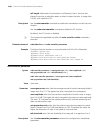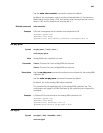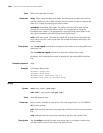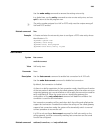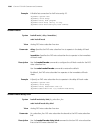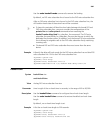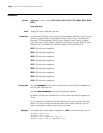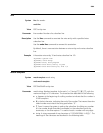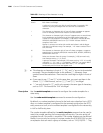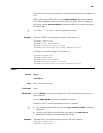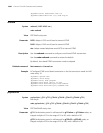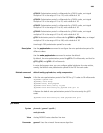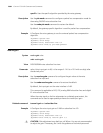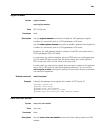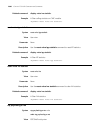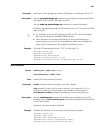
2600 CHAPTER 173: VOIP CONFIGURATION COMMANDS
n
■ The character or characters in front of “!”, “%”, and “+” are not to be matched
accurately. They are handled similar to the wildcard “.”. Moreover, these
symbols cannot be used alone. There must be a valid digit or digits in front of
them.
■ If you want to use “[ ]” and “( )” at the same time, you must use them in the
format “( [ ] )“. Other formats, such as “[ [ ] ]” and “[ ( ) ]” are illegal.
■ “-” can only be used in “[ ]”, and it only connects the same type of characters,
such as “0-9”. The formats like “0-A” are illegal.
Description Use the match-template command to configure the number template for a
voice entity.
Use the
undo match-template command to remove the configuration.
By default, no number template is bound to the local voice subscriber line in POTS
view, no number template is configured for the terminating side when the POTS
entity serves as a trunk, and no number template is configured for the voice entity
in VoIP or VoFR entity view.
The number template defined by the match-template command can be used to
match the number reaching the corresponding voice entity. The voice entity will
complete the call if the match is successful. The number template can be defined
flexibly. It can not only be a string of a unique number like 01016781234, but also
an expression that can match a group of numbers, such as “010[1-5]678...”. They
Table 683 Meanings of the characters in string
Character Meaning
0-9 Numbers from 0 to 9. Each means a digit.
# and * Each means a valid digit.
. A wildcard. It can match any digit of a valid number. For example, 555. . . .
matches any string that begins with 555 and with four additional
characters.
! The character or characters right in front of it does not appear or appears
once. For example, 56!1234 can match 51234 and 561234.
+ The character or characters right in front of it appears once or several times.
But its appearance at the beginning of the whole number means the
number is E.164-compliant. For example, (1) 9876(54)+ matches 987654,
98765454, 9876545454 and so on. (2) +110022 indicates 110022 is
compliant with E.164.
- Hyphen. It connects two values (the smaller one before it and the bigger
one after it) to indicate a range. For example, “1-9” means numbers from 1
to 9 (inclusive).
% The character or characters right in front of it does not appear, or appears
several times. For example, 9876(54)% matches 9876, 987654, 98765454,
9876545454 and so on.
[ ] Select one character from the group. For example, [1-36] can match only
one character among 1, 2, 3, and 6.
( ) A group of characters. For example, (123) means a string “123”. It is usually
used with “!”, “%”, and “+”. For example, “408(12)+” can match 40812
or 408121212. But it cannot match 408. That is, “12” can appear
continuously and it must at least appear once.



